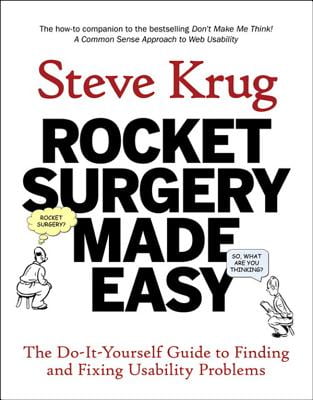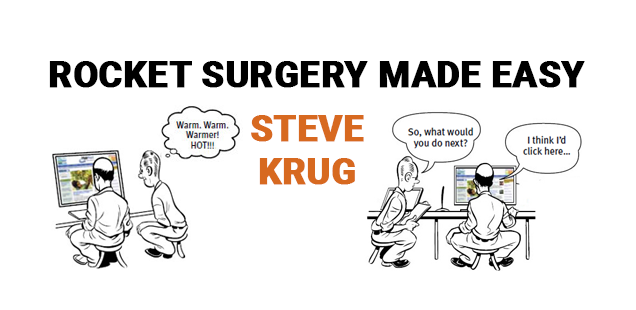

#STEVE KRUG ROCKET SURGERY MADE EASY PDF SERIES#
The tasks (35 minutes): Watch the participant perform a series of tasks you have prepared for them beforehand.This will give you an idea of how easy it is to understand your home page, as well as how familiar the participant is with your domain. The Home page tour (3 mins): Open the Home page of the site you’re testing, and ask the participant to look around and tell you what they make of it.This helps put them at ease and gives you an idea of how computer-savvy they are. The questions (2 mins): Ask the participant a few questions about themselves.Welcome (4 mins): Explain how the test will work so that the participant will know what to expect.A typical one-hour test can be broken down into: Get as many people as possible to observe the tests - the designers, engineers, project managers, executives etc.ĭuring a usability test, you will record the participant’s voice and the screen, as well as share both live with observers in another room.Recruit loosely, and grade on a curve - you don’t need to find someone who fits the exact mold of your users since most usability problems can be uncovered by testing with just about anyone. Test with three participants each round.Reserve one morning a month (say the third Thursday every month) for a round of testing, debriefing, and deciding what to fix.Here are some of Steve’s recommendations: Steve calls this kind of testing “Do It Yourself Usability Testing” since it’s supposed to be cheap, easy-to-do and takes just a morning a month. When it comes to usablity testing, any testing with anyone is better than no testing, and a bit of testing earlier is better than a lot of testing later. Here are my notes from the book: Usability Testing I was in awe of how excellent writing makes a world of difference when it comes to presenting a topic that otherwise could have been pretty bland. He does an excellent job of keeping you entertained and making sure you actually finish the book. I really loved Steve Krug’s writing style. Rocket Surgery Made Easy adds demonstration videos to the proven mix of clear writing, before-and-after examples, witty illustrations, and practical advice that made Don't Make Me Think so popular.This book is all about Usability Testing and builds upon the basics covered in Don’t Make Me Think that I covered last week. Fix the problems that you find, using his "The least you can do" approachīy paring the process of testing and fixing products down to its essentials ("A morning a month, that's all we ask"), Rocket Surgery makes it realistic for teams to test early and often, catching problems while it's still easy to fix them.Keep your focus on finding the most important problems (because no one has the time or resources to fix them all).Test any design, from a sketch on a napkin to a fully-functioning Web site or application.(As he said in Don't Make Me Think, "It's not rocket surgery".)Using practical advice, plenty of illustrations, and his trademark humor, Steve explains how to:

In this how-to companion to Don't Make Me Think: A Common Sense Approach to Web Usability, Steve Krug spells out a streamlined approach to usability testing that anyone can easily apply to their own Web site, application, or other product. But with a typical price tag of $5, 000 to $10, 000 for a usability consultant to conduct each round of tests, it rarely happens. It's been known for years that usability testing can dramatically improve products.


 0 kommentar(er)
0 kommentar(er)
